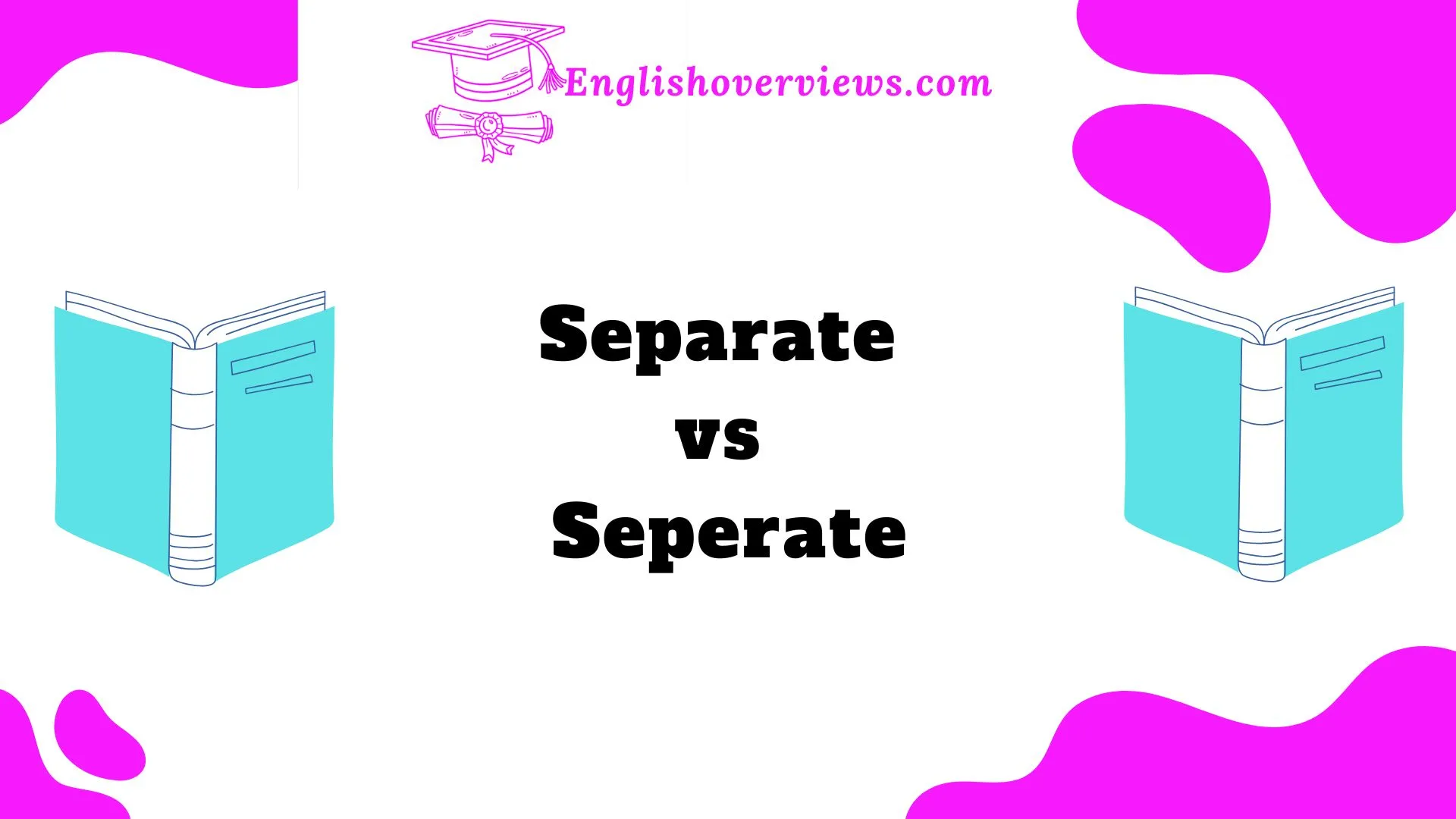Spelling can be tricky, especially when two similar-looking words get mixed up, like separate and seperate. It’s easy to slip into a bad habit of misspelling these words, but doing so can affect the clarity of your writing. While many people confuse the two, understanding the difference can elevate your writing and show your attention to detail.
This article will clear up the confusion between separate and seperate, explore their meanings, offer tips for remembering the correct spelling, and explain why spelling matters in communication.
Whether you’re writing for a blog, school, work, or just in casual communication, knowing how to spell separate correctly will improve your professionalism. Let’s dive in!
The Common Mix-Up: Seperate vs. Separate
It’s a common sight: you’re typing away, and without even thinking, you hit the wrong key, typing seperate instead of separate. In fact, it’s one of the most common spelling errors people make. But why does this mix-up happen? Let’s look at the confusion more closely.
- Phonetic similarities: The biggest reason people confuse these words is how they sound. The pronunciation of separate is /ˈsɛpəreɪt/, and it sounds very similar to seperate, which creates the misconception that “seperate” could be correct.
- Visual confusion: The two words look almost identical, with the only difference being the second “a” in separate that many people forget.
The result? Countless instances of people misspelling separate as seperate, which could make your writing appear careless.
Understanding the Correct Spelling
The correct spelling is separate with two “a”s. This is the only proper form of the word. Let’s break down why this is so important.
The Etymology of Separate
The word separate comes from the Latin word separare, which means “to set apart” or “to divide.” The two “a”s in the middle of the word reflect this original Latin structure. Understanding its origin helps reinforce why the spelling seperate doesn’t make sense. The structure is simply incorrect because it omits one of the necessary vowels.
Why “Seperate” is Incorrect
Seperate is not a legitimate variation of the word. While it might be a typo or an unconscious error, the truth is that it’s a spelling mistake that shouldn’t be used in formal writing. The extra “a” helps preserve the original meaning and sound of the word.
Separate as an Adjective and a Verb
Separate can be used as both an adjective and a verb. Let’s break down the two roles it plays.
Separate as an Adjective
As an adjective, separate describes two or more things that are not together. It means “distinct” or “individual.”
- Example: “We need separate files for each project.”
- Example: “They decided to stay in separate rooms during the trip.”
Separate as a Verb
When used as a verb, separate means the action of making two or more things distinct.
- Example: “The teacher asked us to separate into smaller groups.”
- Example: “Can you separate the blue shirts from the red ones?”
Both uses of separate are important to understand so you can choose the right form based on context.
Why ‘Seperate’ Is a Spelling Error
You might wonder why people often make the mistake of writing seperate instead of separate. There are a few reasons behind this common error.
Phonetic Confusion
The pronunciation of separate sounds like “se-per-ate” (with a single a in the middle), leading many to mistakenly omit the second “a.”
Typing Mistake
Sometimes, the second “a” gets missed when typing quickly, or it’s simply a typo. This is especially common when people aren’t paying attention while typing.
Lack of Awareness
Some people may simply not be aware that seperate is incorrect. They may not have learned the proper spelling or never encountered the word written correctly enough to remember.
Real-World Example
Consider this case study: An employee in a professional setting typed an email that included the phrase, “Please seperate the documents into categories.” This error, though minor, undermines the credibility of the message and can be seen as a sign of carelessness.
Memory Tricks for Spelling ‘Separate’ Correctly
If you often struggle with spelling separate correctly, don’t worry. There are several tricks to help you remember the right way to write it.
Mnemonic Method
Think of the word “rat” inside the word separate. The mnemonic could be: “There’s a rat in separate.” This quirky trick helps you recall the correct spelling by focusing on the “rat” nestled between the “e” and the second “a.”
Visualization
Imagine separating items into distinct piles. In each pile, there are two things. This visualization of “two” helps you remember that separate contains two “a”s.
Phonetic Clue
Remember that the word “separate” sounds like “se-puh-rate,” with two vowels in the middle, which you can link to the “rat” trick.
Visual and Mnemonic Aids
Here are a few additional mnemonic aids to reinforce the correct spelling:
| Mnemonic | Explanation |
| Separate the rat | “Rat” is in the middle of separate to help you remember the correct spelling. |
| Two a’s in separate | A simple visual clue to remind you that there are two “a”s. |
| Separate = Two piles | Imagining two piles will help reinforce the idea of two vowels. |
You can use these tricks when writing to ensure you get the spelling right every time.
Phonetic Clues and Pronunciation
Understanding how the word is pronounced can help you remember how it’s spelled. The correct pronunciation of separate is /ˈsɛpəreɪt/, with two vowels clearly pronounced.
The mistake of seperate arises because the word sounds so similar to “se-per-ate.” This phonetic similarity can cause the confusion, but remembering that the word separate has two vowels in the middle can clear things up.
Examples of ‘Separate’ in Various Contexts
Let’s take a look at how separate is used in various contexts to give you a clearer picture.
Formal Writing
In professional writing, proper spelling is crucial. Here’s an example of separate used correctly:
- “We need separate accounts for each department’s budget.”
Casual Conversation
In casual settings, separate is used to describe dividing things:
- “Can you separate the laundry by color?”
Scientific or Academic Writing
In academic papers, separate might refer to different subjects or entities:
- “The two species separate after the breeding season.”
In all these examples, proper spelling plays a key role in clear communication.
The Importance of Correct Spelling in Communication
Correct spelling isn’t just about avoiding errors. It can affect the way people perceive you, your professionalism, and your credibility.
Professionalism and Credibility at Stake
Imagine submitting a report or an email with frequent spelling mistakes. It can give the impression that you’re careless, which can harm your reputation in a workplace or academic setting.
First Impressions Matter
Whether you’re writing an email to a potential client or drafting a resume, correct spelling shows you care about the details. It’s the little things that make a big difference.
Clear Communication
Spelling errors can cause confusion. For example, writing “seperate” could make someone wonder if you meant something else. Proper spelling helps your audience easily understand your message without unnecessary confusion.
Synonyms for ‘Separate’: Expanding Your Vocabulary
While separate is a great word, knowing synonyms for it can help diversify your writing. Here are a few alternatives:
| Synonym | Example |
| Divide | “Please divide the documents into categories.” |
| Distribute | “The teacher will distribute the worksheets.” |
| Isolate | “The scientist will isolate the chemical compound.” |
| Detach | “You need to detach the parts before assembly.” |
Each synonym carries a slightly different nuance, so make sure to choose the one that best fits your context.
Tools and Tips for Perfecting Your Spelling
If you’re struggling with spelling, here are some tools and tips to help you get better.
Digital Tools
There are several online tools and apps that can help with spelling:
- Grammarly: Checks your writing for spelling, grammar, and style issues.
- Hemingway Editor: Helps improve readability, which includes spelling suggestions.
Practice Makes Perfect
To perfect your spelling, you need to practice. Here are a few strategies:
- Flashcards: Write separate on one side and its correct spelling on the other. Quiz yourself regularly.
- Repetition: Write separate multiple times until the spelling sticks in your memory.
Proofreading Tips
Before submitting any work, always proofread. If possible, read your writing aloud to catch mistakes. You can also use online spell checkers to spot typos.
Conclusion
In conclusion, the difference between separate and seperate is simple but significant. Separate is the correct spelling, and understanding this can help you sound more professional and credible in your writing.
By using mnemonic devices, phonetic clues, and proofreading techniques, you can easily avoid the common mistake of writing seperate.
Remember, the key to mastering spelling is practice and attention to detail. So, let’s put this knowledge into action and start spelling separate correctly every time!
FAQs
1. Why do people confuse separate with seperate?
People often confuse separate with seperate because the two words sound similar, and the second “a” can be easily overlooked.
2. How can I remember the correct spelling of separate?
Try the mnemonic “There’s a rat in separate” or visualize two piles to remember the two “a”s in the word.
3. Is seperate ever acceptable?
No, seperate is always a spelling error. The correct form is separate.
4. Why is spelling important in writing?
Correct spelling reflects professionalism and helps ensure clear communication, especially in formal settings. Mistakes can create confusion or cause readers to question your attention to detail.

English Overviews is a resourceful website dedicated to providing valuable content related to grammar and vocabulary. Muhammad Haroon has made notable contributions, sharing insights on various subjects, including WordPress themes and plugins. The primary goal of the site is to help users improve their English language skills effectively.











